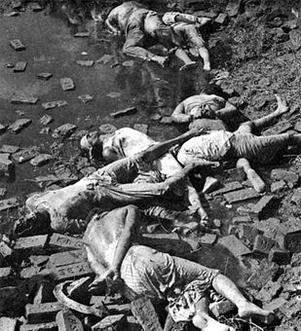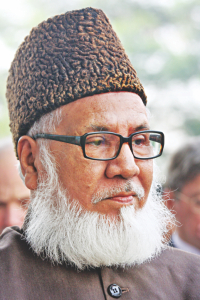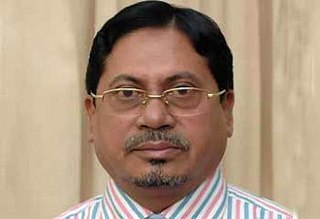This article needs additional citations for verification .(February 2021) |
The following is a list of massacres that have occurred in Bangladesh (numbers may be approximate):
Contents
| Name | Date | Location | Deaths | Notes |
|---|---|---|---|---|
| 1971 Bangladesh genocide | starting 25 March 1971 – 16 December 1971 | Various places in Bangladesh | 200,000–3,000,000 | |
| 1971 Dhaka University massacre | 25 March 1971 | University of Dhaka | 310+ | |
| 1971 killing of Bengali intellectuals | 25 March-14 December 1971 | 1,111 [1] | ||
| Shankharipara massacre | 26 March 1971 | Shankaripara, Dhaka | estimated 8,000 | |
| Ramna massacre | 27 March 1971 | Ramna Kali Temple, Ramna, Dhaka | 250 | |
| Sutrapur massacre | 27 March 1971 | Sutrapur, Dhaka | 15 | |
| Santahar massacre | 27 March - 17 April 1971 | Santahar, Bogra District | 1000+ | |
| Jinjira massacre | 1 April 1971 | across the Buriganga River from Dhaka | 1000+ | |
| Akhira massacre | 17 April 1971 | Baraihat, Dinajpur | 93–125 | |
| Jathibhanga massacre | 21 April 1971 | Jathibhanga, Thakurgaon | 3,000-3,500 | |
| Sree Angan massacre | 23 April 1971 | Sree Angan, Faridpur | 8 | |
| Karai Kadipur massacre | 26 April 1971 | Karai Kadipur, Joypurhat | 370 | |
| Kaliganj massacre | 27 April 1971 | Kaliganj, Rangpur | 400 | |
| Ishangopalpur massacre | 2 May 1971 | Ishangopalpur, Faridpur | 28 | |
| Muzaffarabad massacre | 3 May 1971 | Patiya, Chittagong | more than 300 | |
| Naria massacre | 5 May 1971 | Naria, Sylhet | 28 | |
| Gopalpur massacre | 5 May 1971 | Lalpur Upazila, Natore | 195 | |
| Demra massacre | 13 May 1971 | Demra, Pabna District | more than 900 | |
| Satanikhil massacre | 14 May 1971 | Kewar, Dhaka district | 14 | |
| Baria massacre | 14 May 1971 | Baria, Dhaka district | 200 | |
| Ketnar Bil massacre | 15 May 1971 | Ketnar Bil, Barisal | more than 500 | |
| Char Bhadrasan massacre | ? 1971 | Char Bhadrasan, Faridpur | 50–60 | |
| Hasamdia massacre | 16 May 1971 | Boalmari, Faridpur | 33 | |
| Sendia massacre | 20 May 1971 | Sendia, Faridpur | 127 | |
| Chuknagar massacre | 20 May 1971 | Khulna | 8,000-10,000 | |
| Galimpur massacre | 20 May 1971 | Galimpur, Sylhet | 33 | |
| Dakra massacre | 21 May 1971 | Dakra, Khulna | more than 2,000 | |
| Madhyapara massacre | 22 May 1971 | Palong, Faridpur | 370 | |
| Bhimnali massacre | 22 May 1971 | Bhimnali, Barisal | 15 | |
| Bakhrabad massacre | 24 May 1971 | Bakhrabad, Comilla | 142 | |
| Burunga massacre | 26 May 1971 | Burunga, Sylhet | 71–94 | |
| Bagbati massacre | 27 May 1971 | Bagbati, Pabna | more than 200 | |
| Barguna massacre | 29–30 May 1971 | Barguna sub-divisional jail, Patuakhali | more than 100 | |
| Daldalia massacre [2] [3] | 2 June 1971 | Daldalia, Rangpur | 20 | Murder 20 of unarmed Bengali Hindus by the Pakistan Army and Bihari Muslims |
| Golaghat massacre | 13 June 1971 | Golaghat, Nilphamari | 437 | |
| Adityapur massacre | 14 June 1971 | Adiyapur, Sylhet | 63 | |
| Makalkandi massacre | 18 August 1971 | Habiganj, Sylhet | more than 100 | |
| Pomara massacre | 14 September 1971 | Pomara, Chittagong | 13 | |
| Krishnapur massacre | 18 September 1971 | Krishnapur, Sylhet | 127 | |
| Suryamani massacre | 7 October 1971 | Suryamani, Barisal | 24 | |
| Shankharikathi massacre | 4 November 1971 | Shankharikathi, Khulna | 42 | |
| 1974 Ramna massacre | 17 March 1974 | Ramna, Dhaka | 40–50 | |
| Assassination of Sheikh Mujibur Rahman | 15 August 1975 | Dhaka | 36 | President Sheikh Mujibur Rahman was assassinated |
| Bhushanchhara massacre | 31 May 1984 | Bhushanchhara, Barkal Upazila, Rangamati | 400 | |
| 1988 Chittagong massacre | 24 January 1988 | Lal dighi, Chittagong | 370 | |
| Logang massacre | 10 April 1992 | Logang village, Khagrachari District | Unknown | |
| 1999 Jessore bombings | 6 March 1999 | Jessore | 10 | |
| 1999 Khulna mosque bombing | 8 October 1999 | Khulna | 8 | |
| 2001 Ramna Batamul bombings | 14 April 2001 | Ramna Park in Dhaka | 9 | |
| 2001 Gopalganj Roman Catholic church bombing | 1 June 2001 | Roman Catholic church in Gopalganj | 10 | |
| Mymensingh cinema bombings | 6 December 2002 | Mymensingh | 27 | |
| 2003 Tangail shrine bombing | 17 January 2003 | Tangail | 7 | Two bombs exploded in Fair, 20 wounded |
| Banshkhali carnage | 18 November 2003 | Sheelpara, Sadhonpur village, Banshkhali Upazila, Chittagong District | 11 | Some individuals set fire to the house of Tejendra Lal Sheel using gunpowder killing 11 members of family including six children |
| 2004 Dhaka grenade attack | 21 August 2004 | Bangabandhu Avenue, Dhaka | 24 | 13 grenades were thrown into a crowd at an anti-terrorism rally organized by the Awami League. |
| 2005 November Bangladesh court bombing | 29 November 2005 | Gazipur and Chittagong | 8 | Series of simultaneous suicide bombing of courts in Chittagong and Gazipur is carried out by Jamaat-ul-Mujahideen Bangladesh, killed 8 people and injured over 100 |
| 2005 Netrokona bombing | 8 December 2005 | Netrokona | 8 | A suicide bombing in Netrokona results in the deaths of eight people |
| Bangladesh Rifles revolt | 25 February — 2 March 2009 | Pilkhana, Dhaka | 74 | Soldiers of border security force Bangladesh Rifles (BDR) mutiny and take the commanding army officers and their families hostages at the force's headquarters in Pilkhana, Dhaka. 57 army officers are killed along with 17 civilians by the mutineers |
| 2016 Dhaka attack | 1 June 2016 | Holey Artisan Bakery, Gulshan Thana, Dhaka | 29 | Gunmen attacked a restaurant popular with foreigners in the wealthy Gulshan Thana area |
| 2017 South Surma Upazila bombings | 25 March 2017 | South Surma Upazila, Sylhet | 11 (including 4 suicide bombers) | A suicide bombing killed four civilians, two police officers and wounded around 40 during a security forces raid on a suspected terrorist hideout in South Surma Upazila. ISIL claimed responsibility. Four militants were also killed |









